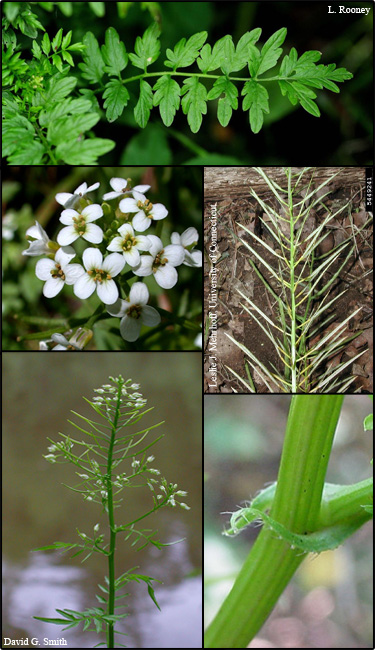Narrowleaf bittercress (Cardamine impatiens)
 Common Names: Bitter cress
Common Names: Bitter cressDescription: Easily dispersed due to its seed shooting ability; can form dense stands, outcompeting native species.
Habit: Herbaceous annual or biennial with spreading leaves; grows up to 60 cm (2 ft) tall.
Leaves: Pinnately divided with numerous (6-20), sharply toothed leaflets; membrane-like, narrow, pointed auricles at the leaf base; basal leaves are arranged in a rosette and pinnately divided, 3-11 leaflets with rounded lobes.
Stems: Erect; glabrous.
Flowers: Small, white in color, up to 2.5 mm (0.1 in.) long, petals lacking or shorter than the sepals; bloom May through August.
Fruit and seeds: Slender seedpods (siliques) on spreading-ascending to erect pedicels, 1.5-2 cm (0.6-0.8 in.) long, 10-24 seeds, ripen from May to September.
Habitat: Established in Michigan; found on banks, along thicket margins, shady woods and on moist limestone rocks and cliffs.
Reproduction: By seeds expelled from siliques.
Similar species: Native sand bitter-cress (C. parviflora), Pennsylvania bitter-cress (C. pensylvanica), tansy-mustard (Descurainia pinnata) and common yellow-cress (Rorippa palustris) lack narrow-leaved bittercress? characteristic narrow, pointed auricle at the leaf base.
Monitoring and rapid response: Monitor moist forested sites in spring and summer; can be identified by its sagittate-auriculate leaf bases. Hand pull and remove all plants before seed dispersal. As this species has a limited distribution in Michigan, it is important to document new occurrences. Please obtain flowering or fruiting specimens with the diagnostic leaf bases and submit to: Anton Reznicek, Curator (Vascular Plants), University of Michigan Herbarium, 3600 Varsity Drive, Ann Arbor, MI 48108-2287. Credits: The Michigan Natural Features Inventory (MNFI) has partnered with MISIN to provide the information in this fact sheet. Species images and/or information were used with permission from "A Field Identification Guide to Invasive Plants in Michigan's Natural Communities" and "A Field Guide to Invasive Plants of Aquatic and Wetland Habitats for Michigan.
Common Name: | Narrowleaf bittercress |
Scientific Name: | Cardamine impatiens |
Family: | Brassicaceae (Mustard) |
Duration: | Annual, Biennial |
Habit: | Herbs |
USDA Symbol: | CAIM |
